China launched a spacecraft Tuesday to collect and return samples from the moon, the world's first moon-sample mission for more than 40 years.
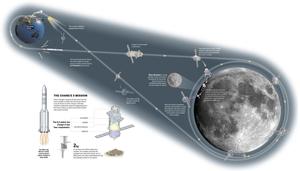 (MUKESH MOHANAN / CHINA DAILY)
(MUKESH MOHANAN / CHINA DAILY)
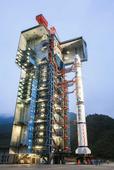 Chang'e 1 is ready to be launched by the Long March 3A carrier rocket on Oct 24, 2007, from the Xichang Satellite Launch Center in Sichuan province. (WEI QING / FOR CHINA DAILY)
Chang'e 1 is ready to be launched by the Long March 3A carrier rocket on Oct 24, 2007, from the Xichang Satellite Launch Center in Sichuan province. (WEI QING / FOR CHINA DAILY)
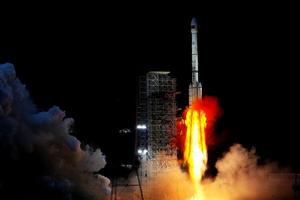 Chang'e 2, attached to the Long March 3C carrier rocket, is launched on Oct 1, 2010, from the Xichang center. (WEI QING / FOR CHINA DAILY)
Chang'e 2, attached to the Long March 3C carrier rocket, is launched on Oct 1, 2010, from the Xichang center. (WEI QING / FOR CHINA DAILY)
 Chang'e 3 waits to be launched from the Xichang center on Dec 1, 2013. (PHOTO PROVIDED TO CHINA DAILY)
Chang'e 3 waits to be launched from the Xichang center on Dec 1, 2013. (PHOTO PROVIDED TO CHINA DAILY)
 Chang'e 4's lander on the moon. (PHOTO / XINHUA)
Chang'e 4's lander on the moon. (PHOTO / XINHUA)
Expedition tasked with number of firsts for China
The Chang'e 5 lunar mission will need to overcome a succession of challenges and difficulties before it can be declared a complete success, project insiders said.
Mission spokesman Pei Zhaoyu said Chang'e 5 will be the first Chinese spacecraft to carry out sample collection and launch operations on an extraterrestrial body, and these maneuvers will be extremely demanding and sophisticated in terms of technology and engineering complexity.
Mission spokesman Pei Zhaoyu said Chang'e 5 will be the first Chinese spacecraft to carry out sample collection and launch operations on an extraterrestrial body, and these maneuvers will be extremely demanding and sophisticated in terms of technology and engineering complexity
After the samples are collected and packed into the ascender, it will need to be lifted into lunar orbit to rendezvous and dock with the combined orbiter and re-entry capsule in an exceptionally accurate, delicate manner. Otherwise, it will be damaged and fail to deliver the samples, he added.
Even at the very beginning of the mission, Chang'e 5 had to go through some new operations, said Pei, who is deputy director of the China National Space Administration's Lunar Exploration and Space Program Center. He explained that it was the first Chinese lunar mission to use the Long March 5 heavy-lift carrier rocket and the Wenchang Space Launch Center in Hainan province. All the previous Chang'e programs were carried on Long March 3 rockets launched from the Xichang Satellite Launch Center in Sichuan province.
Yu Dengyun, deputy chief designer of China's lunar exploration program, said: "First of all, Chang'e 5's most important task will be collecting lunar samples. The environment on the lunar surface, such as the gravity there, is very different from that on Earth. So we must ensure that our technologies are functional and reliable during the collection and packing processes.
READ MORE: China to launch Chang'e-5 lunar probe this year
"The next challenge will be lifting the sample-carrying ascender from the moon. All of our launches so far were made from Earth, but the coming launch will take place on lunar soil and use the Chang'e 5's lander as the launchpad. Consequently, the challenge will be whether our equipment can handle the complicated operation as it was designed to do."
Previous rendezvous and docking by Chinese spacecraft occurred in low-Earth orbit-hundreds of kilometers above the planet-but this time it will take place in lunar orbit nearly 380,000 km away, Yu said.
The last challenge, he said, will emerge during the re-entry process as the re-entry capsule will descend through Earth's atmosphere at a speed of 11.2 kilometers per second, much faster than almost all previous Chinese spacecraft.
"The ultrafast speed will verify the aerodynamic design, heat-resistant materials and flight control system on the re-entry module," Yu said.
ALSO READ: China's Chang'e-4 probe switches to dormant mode
 A Long March-5 rocket, carrying the Chang'e-5 spacecraft, blasts off from the Wenchang Spacecraft Launch Site on the coast of southern island province of Hainan, on Nov 24, 2020. (PHOTO / XINHUA)
A Long March-5 rocket, carrying the Chang'e-5 spacecraft, blasts off from the Wenchang Spacecraft Launch Site on the coast of southern island province of Hainan, on Nov 24, 2020. (PHOTO / XINHUA)
Reasons for predawn launch time explained
Many people have asked why the China National Space Administration chose to launch the Chang'e 5 in the early morning, which forced those wanting to witness the spectacular event to get up well before sunrise.
The robotic lunar probe was sent from the Wenchang Space Launch Center in the island province of Hainan, South China, at 4:30 am.
The launch time was decided by mission planners and rocket designers based on several considerations, said Qian Hang from the China Academy of Launch Vehicle Technology, which built the Long March 5 carrier rocket used to lift the probe.
"The first element we considered when choosing the launch time was the preferred trajectories and the relative position between Earth and the moon," said Qian, from the academy's general design department. "The selected time must fit with several requirements - from the trajectories of the rocket, the orbiter as well as the re-entry capsule."
The second factor taken into account was the sun.
"Launching the rocket before sunrise helped to avoid the impact of solar radiation on the rocket, especially a possible burst of solar wind," he said.
The third reason behind the early morning launch was the amount of cloud cover. At night, the cover is thinner, creating favorable conditions for signals communications between ground control and the Chang'e 5.
The last consideration was monitoring and tracking Chang'e 5 from the ground, Qian said. If the mission started in the daytime, the strong sunlight could "dazzle" the telescopes. Instead, the night sky allowed ground-based monitors to better track and observe the trajectory of the lunar probe after it separated from the rocket, he said.
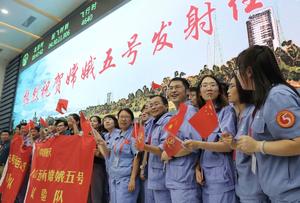 Space workers celebrate the successful launch of Chang'e 5 from the Wenchang Space Launch Center in Hainan province on Tuesday. (PHOTO / XINHUA)
Space workers celebrate the successful launch of Chang'e 5 from the Wenchang Space Launch Center in Hainan province on Tuesday. (PHOTO / XINHUA)
How it took decades for space program to take off
Back in 1970, the year China launched its first satellite, some scientists suggested that the government should start a lunar exploration program.
However, their suggestion was turned down by then Premier Zhou Enlai due to technological and financial difficulties.
In 1997, several top Chinese scientists launched an initiative calling for the central government to pay greater attention to lunar exploration. After that, the country's science community kept urging space authorities to undertake lunar programs. In November 2000, the government announced in a white paper that preparatory research on lunar exploration had been included in its space planning program.
In February 2003, the government said it was ready to open a lunar program and appointed three scientists to head the project team.
In January 2004, the first phase of the Chang'e program was officially approved, marking the formal opening of China's lunar exploration mission.
After nearly four years of preparations, the first lunar probe, Chang'e 1, was launched on Oct 24, 2007, from the Xichang Satellite Launch Center in Sichuan province.
It was tasked with testing and verifying China's lunar probe technologies, obtaining images of the moon and performing scientific surveys.
It obtained a lot of scientific data and generated images for the nation's first map of the entire lunar surface. In March 2009, the probe made a controlled crash on the lunar surface.
Chang'e 2, which made technical improvements on Chang'e 1, was launched on Oct 1, 2010, from the Xichang center to carry out high-definition imaging of the moon and scout possible landing sites for the next mission. It completed its tasks and left lunar orbit.
Chang'e 3, a milestone in China's space exploration history, was launched on Dec 2, 2013, from the satellite center in Sichuan.
It was the first Chinese spacecraft to land on the moon, and the first vessel to achieve that since Luna 24, a probe of the former Soviet Union, performed the same feat in August 1976. Chang'e 3 carried the first Chinese lunar rover, Yutu, which collected data for nearly 1,000 days that was sent back to Earth via a relay satellite in lunar orbit.
On Dec 8, 2018, China launched Chang'e 4 to explore the far side of the moon, which faces away from Earth. After 26 days, the spacecraft made a soft landing in the Von Karman crater in the South Pole-Aitken Basin, beginning humanity's first close observation of the "dark side of the moon".
The Chang'e 4 mission has enabled scientists to deepen their knowledge of the moon and its early history, as well as that of the solar system. Its Yutu 2 rover is the first to explore the far side of the moon.
Future probes already mapped out by administration
While the lunar quest of Chang'e 5 has just begun, engineers have already mapped out the schedules for China's future moon missions.
According to mission planners at the China National Space Administration, Chang'e 6 is scheduled to be launched around 2023. Its mission is to land at the moon's south pole and bring back rock and soil samples. Chang'e 7 is set to conduct a thorough investigation of the lunar south pole in 2024. Chang'e 8 will be tasked with testing and verifying cutting-edge technologies that may be applied in future moon expeditions, including a possible lunar outpost.
The exact launch date and landing site of the Chang'e 6 mission will be determined by the results of the Chang'e 5 mission, said Liu Jizhong, head of the administration's lunar program.
Like its predecessor, Chang'e 6 will consist of four components-orbiter, lander, ascender and re-entry module.
In addition to its own mission payloads, the administration will provide 20 kilograms of storage onboard Chang'e 6 to hold scientific apparatus from domestic and foreign institutes as well as Chinese private enterprises. The spacecraft's orbiter will carry 10 kg of such devices, and the other 10 kg will be mounted on the lander, Liu said.
By comparison, Chang'e 7 will consist of an orbiter, a relay satellite, a lander, a rover and a flyby craft, according to a mission plan published on the website of China's lunar exploration program.
The rover, which will become the nation's third vehicle on the moon, will carry a lunar penetrating radar, a lunar surface magnetometer and a Raman spectrometer.
Pang Zhihao, a former researcher at the China Academy of Space Technology and a space science author, said Chang'e 6 and 7 would focus on the moon's south pole because previous missions have found traces of "water ice" at the lunar poles.
"The next missions can further investigate the existence of water, which can be used to support manned scientific expeditions to those regions in the future," he said.
"The south pole is also characterized by its long period of sunlight coverage that can sustain a probe's extended operations."
Such missions can also help scientists determine whether the moon's polar regions can support permanent scientific outposts, Pang added.
China's space authorities have a long-term plan to land astronauts on the moon and set up at least one scientific station there. They hope to use the manned missions to carry out scientific surveys and technological research, explore ways to develop lunar resources and strengthen the nation's space capabilities.
Zhou Yanfei, deputy chief designer of China's manned space program, said in September that the country has the capacity to independently land astronauts on the moon because of its technologies, well-trained, innovative professionals and efficient research and management systems.
He said planners, designers and engineers are doing feasibility studies and discussing all aspects of the manned lunar program.
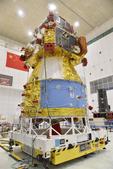 Chang'e 5, China's heaviest and largest lunar probe. (PHOTO PROVIDED TO CHINA DAILY)
Chang'e 5, China's heaviest and largest lunar probe. (PHOTO PROVIDED TO CHINA DAILY)
Experts expect major contributions from mission
Space experts and educators from around the world are closely following the Chang'e 5 mission and are optimistic it can achieve its targets.
Professor Martin Sweeting, a fellow of the Royal Society of the United Kingdom and a distinguished professor of space engineering at the University of Surrey, said the international science community has been looking forward to the mission and the first collection of lunar samples since 1976.
He said following China's extremely successful Chang'e 4 mission to the moon's far side, lunar samples collected by Chang'e 5 will make "further important contributions" to global knowledge of the composition of previously unexplored near-side regions.
"This mission is particularly relevant considering the renewed interest in the moon following the discovery of water trapped in cold locations of the surface and intensive international preparations for humans to return to the moon," Sweeting said. "China's contribution to this international effort will be very important, much welcomed and greatly valued."
Bonnie Thurber from the Spac-Edge Academy, an educational program under the United States' National Space Society, said: "I am very excited about Chang'e 5. I hope everything goes as planned. It is very important to me that all space scientists share and build on information, because the more we know about the moon and space, the sooner we will be able to set up outposts and move forward. I am very hopeful that China will share the information it collects with the rest of the world's space science programs so we can all grow from this mission."
Alan Gould, emeritus director of the Lawrence Hall of Science Planetarium at the University of California, Berkeley, said the mission is expected to make significant contributions to long-term lunar research goals.
Gould said as Chang'e 5 will be collecting surface samples younger than those brought back last century by the Apollo missions, he expects to see advances in knowledge of the composition of lunar materials.
"Even more exciting is the longer-term goal to establish an international lunar research station," he said, adding he wished the Chang'e 5 team the best of luck.
He also expressed hope for more cooperation between the US and China in space exploration.
Steve Durst, founding director of the International Lunar Observatory Association, a nonprofit organization in Hawaii, described the Chang'e 5 mission as "historic, revolutionary and pioneering".
"The International Lunar Observatory Association has always considered Chang'e 5 as the decisive gateway mission to enable commitment and preparation for China's astronauts to travel to and land on the moon," Durst said.
He said the opportunities and advancements resulting from China's lunar exploration program have been enormous for science, technology, education and business. International collaboration on the basis of equality and mutual benefit will also be fostered, as well as peaceful and productive uses of the moon for the entire humanity.
"I hope the revolutionary Chang'e 5 mission will carry and advance a most important accomplishment of the US Apollo moon landings, as inscribed on the plaque Neil Armstrong and Buzz Aldrin placed on the moon-'We came in peace for all mankind'."
Oded Ben-Horin, an associate professor at the Western Norway University of Applied Sciences in Bergen, Norway, said besides scientific and technological achievements, Chang'e 5 will also act as an inspiration for creative education. He hopes educators around the world will study the findings of the mission and share them with students.
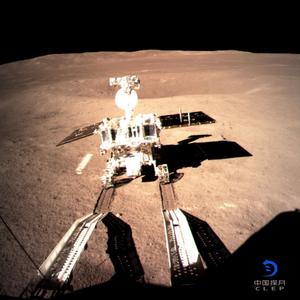 The Yutu 2 rover on the surface of the moon. (PHOTO PROVIDED TO CHINA DAILY)
The Yutu 2 rover on the surface of the moon. (PHOTO PROVIDED TO CHINA DAILY)
Yutu 2 rover still operating on far side of moon
China's Yutu 2 rover has been operating on the lunar surface for 692 Earth days, cementing its status as the second-longest-working rover on the moon, the China National Space Administration said.
The second Chinese lunar rover, Yutu 2 is part of the ongoing Chang'e 4 mission, humanity's first endeavor to land on and closely observe the far side of the moon. The rover has traveled nearly 590 meters since it was deployed on Jan 3 last year.
The administration said Chang'e 4's lander and the rover have finished their 24th lunar-day working session and are now in a dormant state for the lunar night.
A lunar day equals 14 days on Earth, as does a lunar night. During the lunar night, the temperature falls below -180 C, and there is no sunlight to provide power to the probe.
During the most recent lunar day, which started on Nov 9, Yutu 2 continued moving to the northwest of Chang'e 4's landing site in the South Pole-Aitken Basin, one of the largest and deepest known basins in the solar system.
The four scientific apparatus mounted on the vehicle - a panoramic camera, a lunar penetrating radar, a visible and near-infrared imaging spectrometer and the Swedish-developed Advanced Small Analyzer for Neutrals - were activated to conduct scientific investigations.
Their findings during the working session will be used to help scientists reveal the origins of substances beneath the South Pole-Aitken Basin, the space administration said.
Designed and built by China Aerospace Science and Technology Corp, Yutu 2 has six wheels, two solar panels and a radar dish and weighs 140 kilograms.
The record for the longest-working rover on the moon is held by Yutu, China's first lunar rover, which worked on the moon for 972 days, far outliving its designed life span of three months.
It was deployed by the lander of the Chang'e 3 probe, the first Chinese spacecraft to touch down on the moon, in December 2013. Several scientific devices on the lander are still producing data after more than 2,500 days on the near side of the moon, the space administration said.
Yutu broke the previous record for the longest operational lunar rover-321 Earth days-which was held for more than 43 years by the former Soviet Union's Lunokhod 1. It was carried by the Luna 17 spacecraft and landed on the moon on Nov 17, 1970.
The robotic vehicle operated on the lunar surface for 11 lunar days and traversed a total distance of 10.5 kilometers before ceasing operation on October 4, 1971.
In ancient Chinese mythology, Yutu is the white pet rabbit of the lunar goddess Chang'e.


